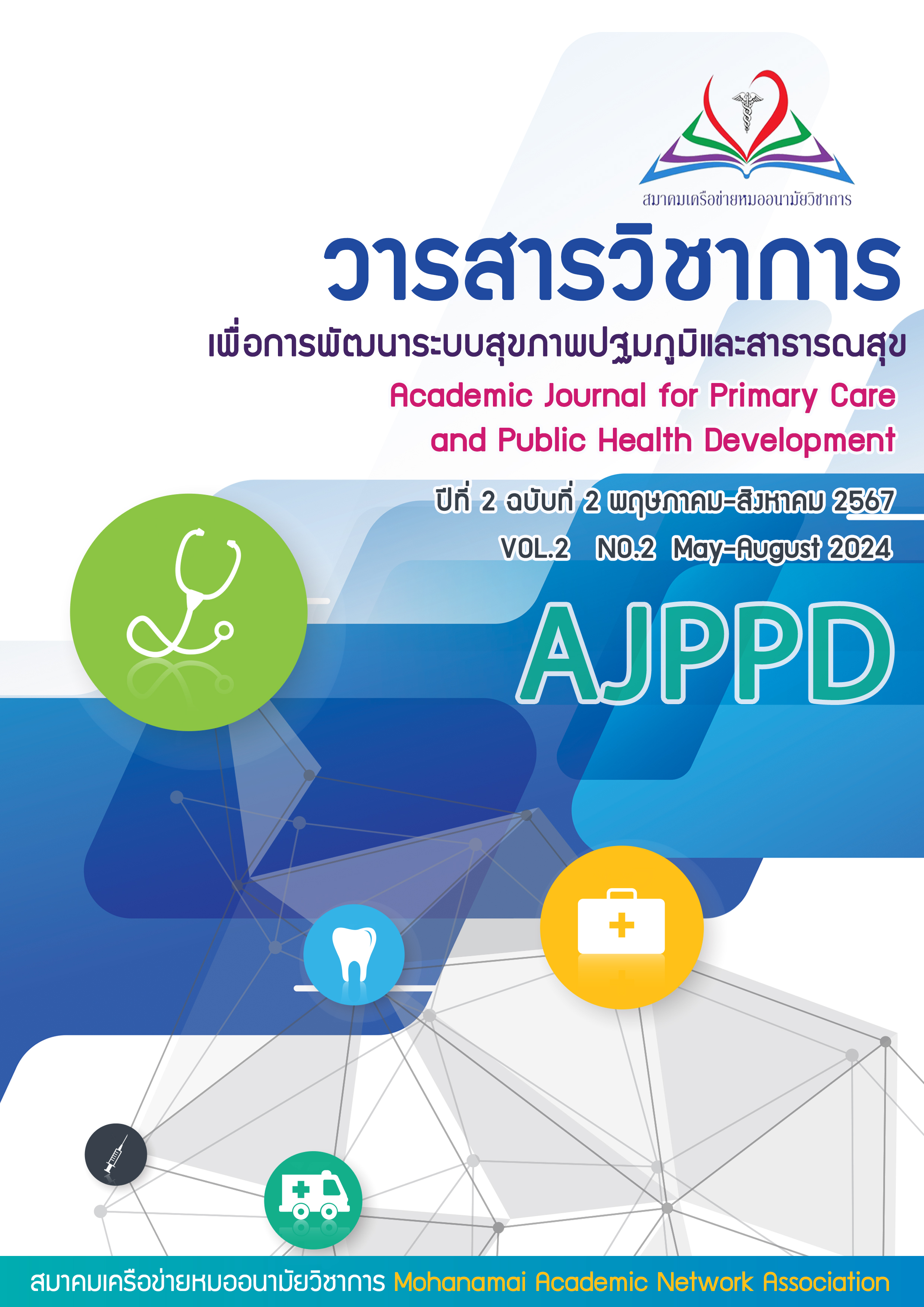Development of Clinical Practice Guidelines for Caring for Patients Receiving Peripheral Intravenous Therapy Inpatient Department, Fao Rai Hospital, Nong Khai Province
Keywords:
Nursing practice guidelines, Peripheral intravenous therapy, ComplicationsAbstract
This research aimed to 1) develop clinical practice guidelines for caring for patients receiving peripheral intravenous therapy, 2) evaluate the result of the guidelines in reducing the incidence of phlebitis, and 3) assess the satisfaction of nurses and patients with the developed guidelines. The study employed a research and development approach, utilizing both quantitative and qualitative methods. It was conducted in three phases: 1) guideline development, involving nursing experts as the sample group, using guideline quality assessment tools and focus group discussions; 2) guideline implementation and evaluation, with a sample of 15 professional nurses and 100 patients receiving intravenous therapy, collecting data before and after guideline implementation, and conducting in-depth interviews; and 3) evaluation and conclusion, analyzing quantitative data using descriptive and inferential statistics, and qualitative data through content analysis.
The results showed that the developed SMART-IV guidelines effectively reduced the incidence of phlebitis from 15% to 7% and decreased the infection rate from 10% to 3% (p<0.01). The response time to symptom changes decreased from 22.5 minutes to 12.8 minutes, and nurses' performance scores increased from 8.0 to 9.5. Both nurses and patients reported high levels of satisfaction with the guidelines. The SMART-IV guidelines effectively reduced complications and improved the quality of care for patients receiving peripheral intravenous therapy. Therefore, it is recommended to promote the implementation of these guidelines in other departments and to continue their development.
References
กิตติรัตน์ สวัสดิ์รักษ์. (2561). การพัฒนาแนวปฏิบัติในการป้องกันการเกิดหลอดเลือดดำอักเสบในผู้ป่วยที่ได้รับสารน้ำทางหลอดเลือดดำ โรงพยาบาลชัยภูมิ. วารสารวิจัยทางการพยาบาล, 5(1), 52-60.
ณิชาภา หน่อตุ้ย และคณะ. (2553). ปัจจัยที่มีผลต่อการเกิดภาวะหลอดเลือดดำอักเสบในผู้ป่วยที่ได้รับสารน้ำทางหลอดเลือดดำ. วารสารพยาบาลศาสตร์, 28(2), 12-20.
ฐิติรัตน์ ลิ้มสินทวีคุณ. (2566). การลดอุบัติการณ์การเกิดหลอดเลือดดำอักเสบในผู้ป่วยที่ได้รับสารน้ำทางหลอดเลือด โรงพยาบาลพุทธชินราช จังหวัดพิษณุโลก. วารสารการแพทย์และสุขภาพ, 13(2), 78-85.
เพ็ญศรี นิลขำ. (2567). การพัฒนาแนวปฏิบัติการดูแลผู้ป่วยที่ได้รับสารน้ำทางหลอดเลือดดำเพื่อป้องกันภาวะแทรกซ้อน. วารสารการพยาบาลและสุขภาพ, 15(3), 115-123.
ลัดดาวัลย์ นรสาร. (2567). การใช้แนวปฏิบัติทางคลินิกในการลดภาวะแทรกซ้อนจากการให้สารน้ำทางหลอดเลือดดำ. วารสารการพยาบาล, 34(1), 43-50.
วิลาวัลย์ สุขศิลป์, อรวรรณ สมบูรณ์จิต, และ สลักจิต สุวรรณศรีสกุล. (2563). การส่งเสริมการปฏิบัติตามแนวทางในการให้สารน้ำทางหลอดเลือดดำ. วารสารพยาบาลศาสตร์, 29(4), 88-95.
Abolfotouh, M. A., Salam, M., Bani-Mustafa, A., White, D., & Balkhy, H. H. (2014). Prospective study of incidence and predictors of peripheral intravenous catheter-induced complications. Therapeutics and Clinical Risk Management, 10, 993–1001.https://doi.org/10.2147/
TCRM.S74685
Centers for Disease Control and Prevention. (2015). Central line-associated bloodstream infections (CLABSI) data and statistics. Retrieved from https://www.cdc.gov/hai/bsi/clabsi-resources.html
Corbett, J., Blegen, M., & Qaseem, A. (2018). The effect of solution pH and osmolarity on intravenous infusion phlebitis rates. Journal of Infusion Nursing, 41(5), 289-295. https://doi.org/10.1097/NAN.0000000000000294
Lim, S. H., Tay, Y. Y., Pua, L. H., & Kee, C. C. (2019). The prevalence and risk factors of peripheral intravenous catheter-related complications among hospitalized adults: A single-center observational study. Journal of Clinical Nursing, 28 (13-14), 2238-2246. https://doi.org/10.1111
/jocn.14841
Monegro, A. F., Muppidi, V., & Regunath, H. (2023). Hospital-acquired infections. StatPearls [Internet]. Retrieved from https://www.ncbi.nlm.nih.gov/books/NBK441857/
Tacconelli, E., Müller, N., Lemmen, S., Mutters, N., Hagel, S., & Meyer, E. (2016). Infection Risk in Sterile Operative Procedures.. Deutsches Arzteblatt international, 113 16, 271-8 . https://doi.org/10.3238/arztebl.2016.0271.

Downloads
Published
How to Cite
Issue
Section
License

This work is licensed under a Creative Commons Attribution-NonCommercial-NoDerivatives 4.0 International License.




